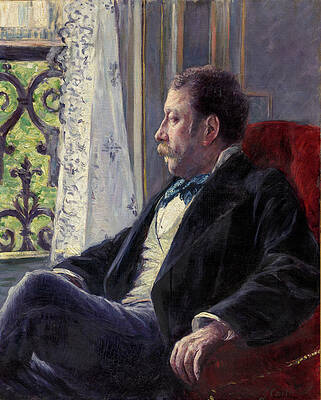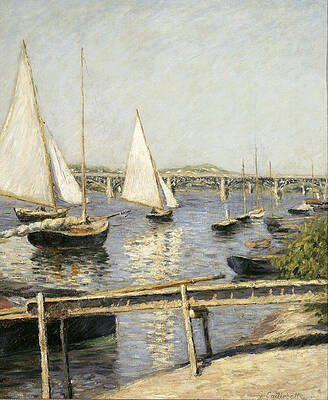Gustave Caillebotte
Paintings
Paris Street in Rainy Weather
Bateaux au mouillage sur la Seine a Argenteuil
Villas in Trouville
Houses in Argenteuil
A Garden in Trouville
The Park Monceau
Promenade of Argenteuil
The Bridge at Argenteuil and the Seine
Massif de Fleurs Jardin du Petit-Gennevilliers
The Orange Trees
Portrait of a Man
Sailing Boats at Argenteuil
Portraits in the Countryside
Mademoiselle Boissiere Knitting






Floor-scrapers, second version





Mademoiselle Boissière Knitting

















Verger aux Pommiers en Fleurs, Colombes


Le Père Magloire allongé dans un bois ou Claude Monnet faisant la sieste


Le pont d'Argenteuil et la Seine

Portrait de Maurice Hugot, enfant

Portrait d'homme écrivant dans son bureau



Les Roses, jardin du Petit-Gennevilliers



Bord de la Seine au Petit-Gennevilliers

Chrysanthèmes blancs et jaunes, jardin du Petit-Gennevilliers

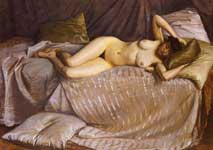
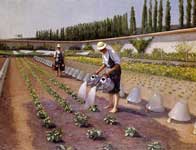
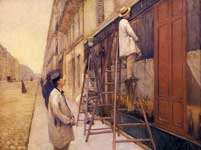
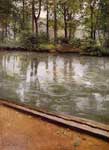
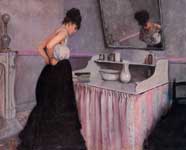
Canotier sur L'Yerres
Fine Art Prints | Greeting Cards | Phone Cases | Lifestyle | Face Masks | Men's , Women' Apparel | Home Decor | jigsaw puzzles | Notebooks | Tapestries | ...
Gustave Caillebotte (French: [ɡystav kɑjbɔt]; 19 August 1848 – 21 February 1894) was a French painter, member and patron of the artists known as Impressionists, though he painted in a much more realistic manner than many other artists in the group. Caillebotte was noted for his early interest in photography as an art form.
Early life
Gustave (right) and his brother Martial
Gustave Caillebotte was born on 19 August 1848 to an upper-class Parisian family living in the rue du Faubourg-Saint-Denis. His father, Martial Caillebotte (1799–1874), was the inheritor of the family's military textile business and was also a judge at the Seine department's Tribunal de Commerce. Caillebotte's father was twice widowed before marrying Caillebotte's mother, Céleste Daufresne (1819–1878), who had two more sons after Gustave, René (1851–1876) and Martial (1853–1910).[1] Caillebotte was born at home on rue du Faubourg-Saint-Denis in Paris, and lived there until 1866 when his father had a home built on rue de Miromesnil. Beginning in 1860, the Caillebotte family began spending many of their summers in Yerres, a town on the Yerres River about 12 miles (20 km) south of Paris, where Martial Caillebotte, Sr. had purchased a large property. It was around this time that Caillebotte probably began to draw and paint.
Caillebotte earned a law degree in 1868 and a licence to practise law in 1870. He was also an engineer. Shortly afterwards, he was drafted to fight in the Franco-Prussian war, and served from July 1870 to March 1871 in the Garde Nationale Mobile de la Seine.[2]
Artistic life
Development
Gustave Caillebotte, about age 30, c. 1878
After the war, Caillebotte began visiting the studio of painter Léon Bonnat, where he began to study painting seriously. He developed an accomplished style in a relatively short period of time and had his first studio in his parents' home. In 1873, Caillebotte entered the École des Beaux-Arts, but apparently did not spend much time there.[3] He inherited his father's fortune in 1874 and the remaining sons divided the family fortune after their mother's death in 1878.[4] Around 1874, Caillebotte met and befriended several artists working outside the official French Academy, including Edgar Degas and Giuseppe de Nittis, and attended (but did not participate in) the first Impressionist exhibition of 1874.[5]
The "Impressionists" – also called the "Independents", "Intransigents", and "Intentionalists" – had broken away from the academic painters showing in the annual Salons.[3] Caillebotte made his debut in the second Impressionist exhibition in 1876, showing eight paintings including Les raboteurs de parquet (The Floor Scrapers) (1875), his earliest masterpiece.[6] Its subject matter, the depiction of labourers preparing a wooden floor (thought to have been that of the artist's own studio) was considered "vulgar" by some critics and this is the probable reason for its rejection by the Salon of 1875. At the time, the art establishment deemed only rustic peasants or farmers as acceptable subjects from the working class.[7] The painting now resides at the Musée d'Orsay. A second version, in a more realistic style resembling that of Degas, was also exhibited, demonstrating Caillebotte's range of technique and his adept restatement of the same subject matter.
Style
Les raboteurs de parquet (1875) - a controversial realist subject
Caillebotte's style belongs to the School of Realism but was strongly influenced by his Impressionist associates. In common with his precursors, Jean-François Millet and Gustave Courbet, as well his contemporary Degas, Caillebotte aimed to paint reality as it existed and as he saw it, hoping to reduce painting's inherent theatricality. Perhaps because of his close relationship with so many of his peers, his style and technique vary considerably among his works, as if "borrowing" and experimenting, but not really sticking to any one style. At times, he seems very much in the Degas camp of rich-colored realism (especially his interior scenes) and at other times, he shares the Impressionists' commitment to "optical truth" and employs an impressionistic pastel-softness and loose brush strokes most similar to Renoir and Pissarro, though with a less vibrant palette.[8]
The tilted ground common to these paintings is very characteristic of Caillebotte's work, which may have been strongly influenced by Japanese prints and the new technology of photography, though evidence of his actual use of photography is lacking.[9] Cropping and "zooming-in", techniques which are also commonly found in Caillebotte's oeuvre, may also be the result of his interest in photography, but may just as likely derive from his intense interest in perspective effects. A large number of Caillebotte's works also employ a very high vantage point, including View of Rooftops (Snow) (Vue de toits (Effet de neige)) (1878), Boulevard Seen from Above (Boulevard vu d'en haut) (1880), and A Traffic Island (Un refuge, boulevard Haussmann) (1880).[10]
Themes
Young Man at His Window [his brother René] (1875), private collection
Caillebotte painted many domestic and familial scenes, interiors, and portraits. Many of his paintings depict members of his family; Young Man at His Window (Jeune Homme à la fenêtre) (1875) shows René in the home on rue de Miromesnil; The Orange Trees (Les Orangers) (1878), depicts Martial Jr. and his cousin Zoë in the garden of the family property at Yerres; and Portraits in the Country (Portraits à la campagne) (1875) includes Caillebotte's mother along with his aunt, cousin, and a family friend. There are scenes of dining, card playing, piano playing, reading and sewing all executed in an intimate, unobtrusive manner which observes the quiet ritual of upper-class indoor life.[11]
His country scenes at Yerres focus on pleasure boating on the leisurely stream as well as fishing and swimming, and domestic scenes around his country home. Often, he used a soft impressionistic technique reminiscent of Renoir to convey the tranquil nature of the countryside, in sharp contrast to the flatter, smoother strokes of his urban paintings. In Oarsman in a Top Hat (1877), he effectively manages the perspective of a passenger in the back of a row boat facing his rowing companion and the stream ahead, in a manner much more realistic and involving than Manet's Boating (1874).[12]
Gustave Caillebotte. Paris Street, Rainy Day, 1877. Art Institute of Chicago.
Caillebotte is best known for his paintings of urban Paris, such as The Europe Bridge (Le Pont de l'Europe) (1876), and Paris Street; Rainy Day (Rue de Paris; temps de pluie, also known as La Place de l'Europe, temps de pluie) (1877). The latter is almost unique among his works for its particularly flat colors and photo-realistic effect which gives the painting its distinctive and modern look, almost akin to American Realists such as Edward Hopper.[13] Many of his urban paintings were quite controversial due to their exaggerated, plunging perspective.[14] In Man on a Balcony (1880), he invites the viewer to share the balcony with his subject and join in observing the scene of the city reaching into the distance, again by using unusual perspective.[15] Showing little allegiance to any one style, many of Caillebotte's other urban paintings produced in the same period, such as The Place Saint-Augustin (1877), are considerably more impressionistic.[16]
Caillebotte's still life paintings focus primarily on food, some at table ready to be eaten and some ready to be purchased, as in a series of paintings he made of meat at a butcher shop.[17] He also produced some floral still-life paintings, particularly in the 1890s. Rounding out his subject matter, he painted a few nudes, including Homme au bain (1884) and Nude on a Couch (1882), which, though provocative in its realism, is ambivalent in its mood — neither overtly erotic nor suggestive of mythology — themes common to many female nude paintings of that era.[18]
Later life
Le jardin du Petit Gennevilliers en hiver (1894), private collection.
Caillebotte acquired a property at Petit-Gennevilliers, on the banks of the Seine near Argenteuil, in 1881, and moved there permanently in 1888.[19] He ceased showing his work at age 34 and devoted himself to gardening and to building and racing yachts, and spent much time with his brother, Martial, and his friend Renoir. Renoir often came to stay at Petit-Gennevilliers, and engaged in far-ranging discussions on art, politics, literature, and philosophy. Never married, Cailebotte appears to have had a serious relationship with Charlotte Berthier, a woman eleven years his junior and of the lower class, to whom he left a sizable annuity.[20]
Caillebotte's painting career slowed dramatically in the early 1890s, when he stopped making large canvases. Caillebotte died of pulmonary congestion while working in his garden at Petit-Gennevilliers in 1894 at age 45, and was interred at Père Lachaise Cemetery in Paris.[21]
For many years, Caillebotte's reputation as a painter was overshadowed by his reputation as a supporter of the arts.[22] Seventy years after his death, however, art historians began reevaluating his artistic contributions. His striking use of varying perspective is particularly admirable and sets him apart from his peers who may have exceeded him in other artistic areas. His art was largely forgotten until the 1950s when his descendents began to sell the family collection. In 1964, The Art Institute of Chicago acquired Paris Street; Rainy Day, spurring American interest in the artist.[23] By the 1970s, his works were being exhibited again and critically reassessed.
The National Gallery of Art (Washington, DC) and the Kimbell Art Museum (Fort Worth, Texas) organized a major retrospective display of Caillebotte's painting, for exhibition in 2015–2016, to pursue further the rediscovery of his work. [24]
Patron and collector
Caillebotte's sizable allowance, along with the inheritance he received after the death of his father in 1874 and his mother in 1878, allowed him to paint without the pressure to sell his work. It also allowed him to help fund Impressionist exhibitions and support his fellow artists and friends (including Claude Monet, Auguste Renoir, and Camille Pissarro among others) by purchasing their works and, at least in the case of Monet, paying the rent for their studios.
Caillebotte bought his first Monet in 1875 and was especially helpful to that artist's career and financial survival.[25] He was precise in his sponsorship; notably absent are works by Georges Seurat and Paul Gauguin, or any of the Symbolists.[8] In 1890 he played a major role in assisting Claude Monet in organizing a public subscription and in persuading the French state to purchase Édouard Manet's 1863 Olympia.[8][26]
Other interests
In addition, Caillebotte used his wealth to fund a variety of hobbies for which he was quite passionate, including stamp collecting, orchid growing, yacht building, and even textile design (the women in his paintings Madame Boissière Knitting, 1877, and Portrait of Madame Caillebotte, 1877, may be working on patterns created by Caillebotte). He was later inscribed in the Roll of Distinguished Philatelists, and the collection he formed with his brother Martial is now in the British Library.[27]
Caillebotte's collection
Yellow Roses in a Vase, 1882, Dallas Museum of Art
Convinced after the death of his younger brother René in 1876 that his own life would be short, Caillebotte wrote his will while still in his twenties.[25] In his will, Caillebotte donated a large collection to the French government. This collection ultimately included sixty-eight paintings by various artists: Camille Pissarro (nineteen), Claude Monet (fourteen), Pierre-Auguste Renoir (ten), Alfred Sisley (nine), Edgar Degas (seven), Paul Cézanne (five), and Édouard Manet (four).[21]
At the time of Caillebotte's death, the Impressionists were still largely condemned by the art establishment in France, which was dominated by Academic art and specifically the Académie des beaux-arts. Because of this, Caillebotte realised that the cultural treasures in his collection would likely disappear into "attics" and "provincial museums". He therefore stipulated that they must be displayed in the Luxembourg Palace (devoted to the work of living artists), and then in the Louvre.[28]
Unfortunately, the French government would not agree to these terms. In February 1896, they finally negotiated terms with Renoir, who was the will's executor, under which they took thirty-eight of the paintings to the Luxembourg. The installation constituted the first presentation of the Impressionists in a public venue in France.[29] The remaining twenty-nine paintings (one by Degas was taken by Renoir in payment for his services as executor) were offered to the French government twice more, in 1904 and 1908, and were both times refused. When the government finally attempted to claim them in 1928, the bequest was repudiated by the widow of Caillebotte's brother Martial Caillebotte. Most of the remaining works were purchased by Albert C. Barnes, and are now held by the Barnes Foundation.[30]
Forty of Caillebotte's own works are now held by the Musée d'Orsay. His Man on a Balcony, Boulevard Haussmann (Homme au balcon, boulevard Haussmann) (1880), sold for more than US$14.3 million in 2000.
References and sources
References
Anne Distel, et al., Gustave Caillebotte: Urban Impressionist, Abbeville Press, New York, 1995, ISBN 0-7892-0041-4, p.311
Kirk Varnedoe 1987, p. 2
Anne Distel, et al., 1995, p.30
Anne Distel, et al., 1995, p.19, 180
Anne Distel, et al., 1995, p.312
Anne Distel, et al., 1995, p.19
Anne Distel, et al., 1995, p.37
Anne Distel, et al., 1995, p.13
Anne Distel, et al., 1995, p.38
Anne Distel, et al., 1995, p.153, 171
Anne Distel, et al., 1995, p.178-180
Anne Distel, et al., 1995, p.74-75
Anne Distel, et al., 1995, p.116
Kirk Varnedoe 1987, p. 3
Anne Distel, et al., 1995, p.143
Anne Distel, et al., 1995, p.110
Anne Distel, et al., 1995, p.233-236
Anne Distel, et al., 1995, p.214
Anne Distel, et al., 1995, p.268
Anne Distel, et al., 1995, p.184
Anne Distel, et al., 1995, p.23
Kirk Varnedoe 1987, p. 10
Anne Distel, et al., 1995, p.25
Morton, Mary & Shackelford, George T.M., 2015
Kirk Varnedoe 1987, p. 4
PBS.org CultureShock, Manet's Olympia
Anne Distel, et al., 1995, p.21-22
Anne Distel, et al., 1995, p.24
Anne Distel, et al., 1995, p.318
Anne Distel, et al., 1995, p.24-25
"Iris Cantor Donates Gustauve Caillebotte “FemmeNue Etendue Sur un Divan” To Met" at urbanartantiques.com
Sources
Berhaut, Marie (1994). Gustave Caillebotte: Catalogue raisonné des peintures et pastels. Paris: Wildenstein Institute.
Broude, Norma (Ed.) (2002). Gustave Caillebotte and the Fashioning of Identity in Impressionist Paris. New Brunswick, New Jersey: Rutgers University Press.
Distel, Anne (1996). Gustave Caillebotte: The Unknown Impressionist. London: The Royal Academy of Arts, London.
Distel, Anne; Druick, Douglas W.; Groom, Gloria & Rapetti, Rodolphe (1995). Gustave Caillebotte, Urban Impressionist. New York: Abbeville Publishing Group (Abbeville Press, Inc.) & The Art Institute of Chicago. (American catalogue for retrospective exhibition in Paris, Chicago, & Los Angeles, 1994–1995.)
Charles, Daniel; Fonsmark, Anne-Birgitte; Hansen, Dorothee; Hedin, Gry & Thomson, Richard (2008). "Gustave Caillebotte". Published by Hatje Cantz. (Exhibition catalogue for exhibition at Ordrupgaard, Copenhagen & Kunsthalle Bremen, 2008–2009)
Morton, Mary & Shackelford, George T.M. (2015). "Gustave Caillebotte: The Painter's Eye". Chicago: University of Chicago Press (Catalogue for retrospective exhibition in Washington, DC, and Fort Worth, Texas 2015–2016.)
Varnedoe, Kirk (1987). Gustave Caillebotte. New Haven: Yale University Press. ISBN 0-300-03722-8
Wittmer, Pierre (1991). Caillebotte and His Garden at Yerres. New York: Harry N. Abrams, Inc.
Artist
A - B - C - D - E - F - G - H - I - J - K - L - M -
N - O - P - Q - R - S - T - U - V - W - X - Y - Z
Retrieved from "http://en.wikipedia.org/"
All text is available under the terms of the GNU Free Documentation License













